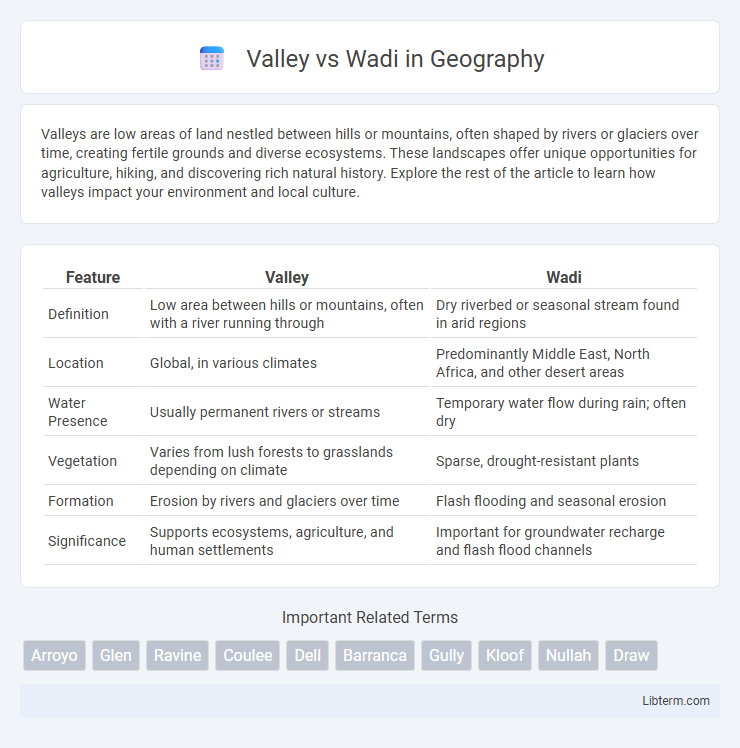Valleys are low areas of land nestled between hills or mountains, often shaped by rivers or glaciers over time, creating fertile grounds and diverse ecosystems. These landscapes offer unique opportunities for agriculture, hiking, and discovering rich natural history. Explore the rest of the article to learn how valleys impact your environment and local culture.
Table of Comparison
| Feature | Valley | Wadi |
|---|---|---|
| Definition | Low area between hills or mountains, often with a river running through | Dry riverbed or seasonal stream found in arid regions |
| Location | Global, in various climates | Predominantly Middle East, North Africa, and other desert areas |
| Water Presence | Usually permanent rivers or streams | Temporary water flow during rain; often dry |
| Vegetation | Varies from lush forests to grasslands depending on climate | Sparse, drought-resistant plants |
| Formation | Erosion by rivers and glaciers over time | Flash flooding and seasonal erosion |
| Significance | Supports ecosystems, agriculture, and human settlements | Important for groundwater recharge and flash flood channels |
Understanding Valleys and Wadis: Key Definitions
A valley is a broad lowland area between hills or mountains, often formed by river erosion, characterized by its U-shaped or V-shaped cross-section and supporting diverse ecosystems. A wadi, primarily found in arid regions, is a dry riverbed or seasonal watercourse that only contains water during periods of heavy rain, playing a crucial role in desert hydrology. Understanding the distinctions between valleys and wadis is essential for geographic studies, environmental planning, and water resource management in different climatic zones.
Geographical Formation: Valley vs Wadi
A valley is a low area between hills or mountains typically formed by river erosion or glacial activity over long geological timeframes, characterized by rich vegetation and permanent water flow. A wadi, common in arid and semi-arid regions, is a dry riverbed or seasonal stream channel that fills with water only during rare rainfalls, shaped predominantly by intermittent flash flooding. The primary distinction lies in the persistent versus ephemeral water presence, making valleys significant for sustained ecosystems, while wadis indicate episodic water flow in desert landscapes.
Climate Influence: How Valleys and Wadis Differ
Valleys and wadis differ significantly in their climate influence, as valleys typically form in temperate or humid regions with consistent water flow, supporting diverse ecosystems and stable agriculture. Wadis, on the other hand, are dry riverbeds found in arid or semi-arid climates, characterized by episodic water flow only during rare rainfall events, resulting in sparse vegetation and limited soil moisture. This climatic distinction shapes the hydrology and biodiversity unique to each landform, with valleys fostering year-round water availability and wadis reflecting extreme seasonal variability.
Regional Distribution: Where Valleys and Wadis Are Found
Valleys are commonly found across various global regions including North America, Europe, and Asia, typically formed by river erosion or glacial activity in temperate and tropical climates. Wadis, on the other hand, are distinctive to arid and semi-arid regions such as the Middle East and North Africa, characterized by dry riverbeds that only contain water during seasonal rainfall. The regional distribution of valleys versus wadis reflects differences in climate, hydrology, and geological processes.
Hydrology: Water Presence in Valleys and Wadis
Valleys typically exhibit perennial water flow, supported by rivers, streams, or groundwater, ensuring consistent hydrological activity. Wadis are dry riverbeds found predominantly in arid regions, carrying water only during intermittent rainfall events or flash floods. The hydrology of valleys supports diverse ecosystems due to sustained moisture, while wadis experience episodic water presence, influencing sediment transport and temporary aquatic habitats.
Ecological Significance: Biodiversity in Valleys vs Wadis
Valleys often host diverse ecosystems with rich biodiversity due to consistent water availability, fertile soils, and varied microhabitats supporting numerous plant and animal species. Wadis, typically dry riverbeds in arid regions, experience sporadic water flow, creating unique but less diverse ecological niches adapted to extreme drought conditions and flash floods. The contrasting moisture regimes in valleys and wadis directly influence species composition, ecosystem resilience, and conservation priorities within these landscapes.
Cultural and Historical Importance
Valleys and wadis hold significant cultural and historical importance in various civilizations, serving as centers for early human settlement and agricultural development due to their fertile lands and access to water. Valleys have been crucial in shaping societies by providing routes for trade, communication, and military campaigns, with famous examples like the Nile Valley fostering ancient Egyptian civilization. Wadis, prevalent in arid regions such as the Middle East and North Africa, historically functioned as vital water sources and seasonal pathways, influencing Bedouin nomadic cultures and ancient trade caravans.
Human Settlement Patterns: Valleys vs Wadis
Valleys often support dense human settlements due to their fertile soil, ample water supply, and favorable climate, enabling agriculture and sustained habitation. Wadis, typically dry riverbeds in arid regions, experience seasonal flooding, leading to sparse and nomadic settlements adapted to water scarcity and harsh conditions. The contrasting hydrological and soil characteristics between valleys and wadis heavily influence the spatial distribution and permanence of human communities.
Tourism and Recreation: Exploring Valleys and Wadis
Valleys, with their lush landscapes and rivers, offer diverse recreational activities such as hiking, camping, and wildlife viewing, attracting tourists seeking scenic beauty and outdoor adventure. Wadis, often dry riverbeds found in desert regions, provide unique opportunities for eco-tourism, photography, and exploration of rare desert flora and fauna during seasonal floods. Both valleys and wadis serve as important natural attractions that support regional tourism by showcasing distinct geological and ecological features.
Conclusion: Comparing the Importance of Valleys and Wadis
Valleys and wadis both serve crucial roles in their environments, with valleys often supporting rich biodiversity and human agriculture due to their perennial water sources and fertile soils. Wadis, characteristic of arid regions, are vital for managing episodic water flow and preventing desertification, supporting unique ecosystems adapted to intermittent water availability. Understanding the distinct ecological and hydrological functions of valleys and wadis highlights their complementary importance in sustaining diverse landscapes and ecological balance.
Valley Infographic

 libterm.com
libterm.com